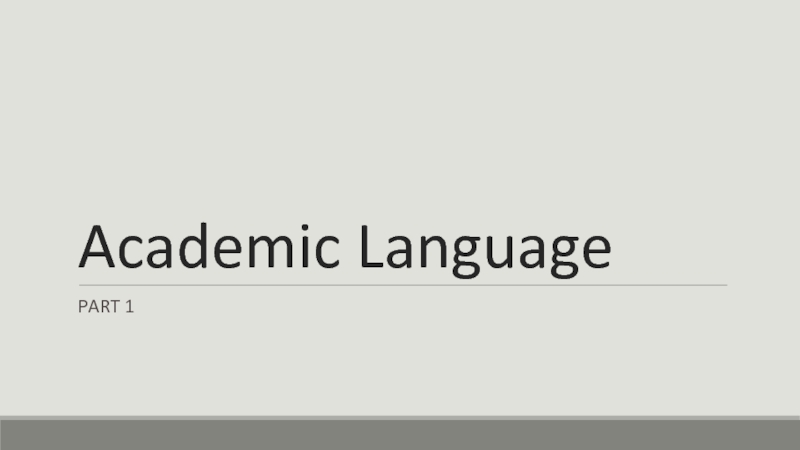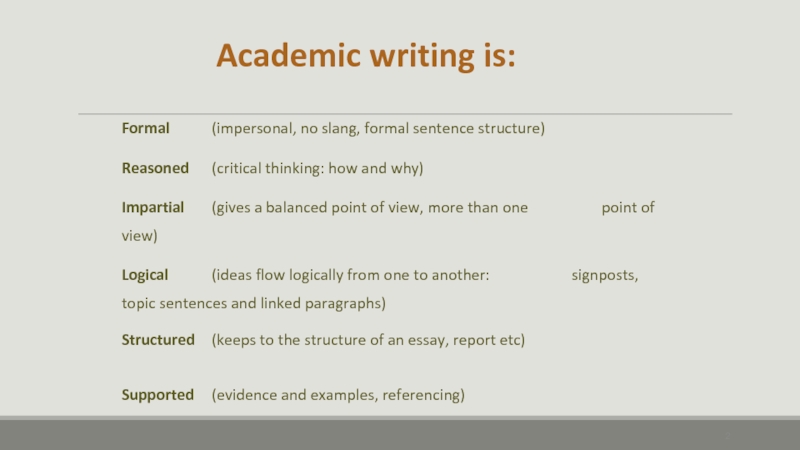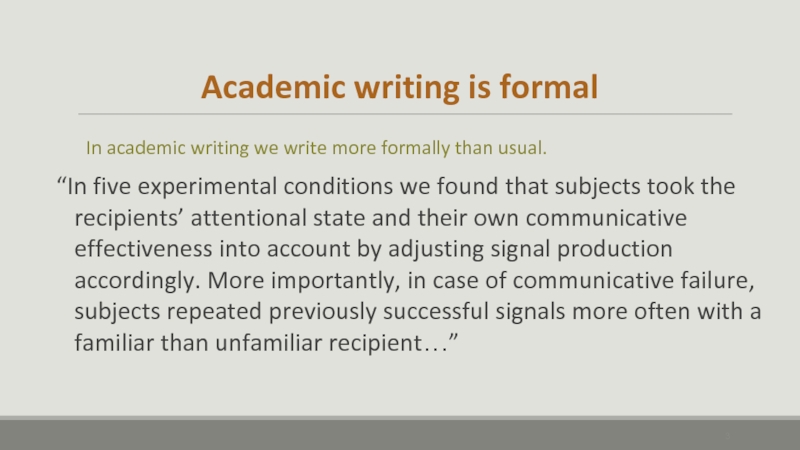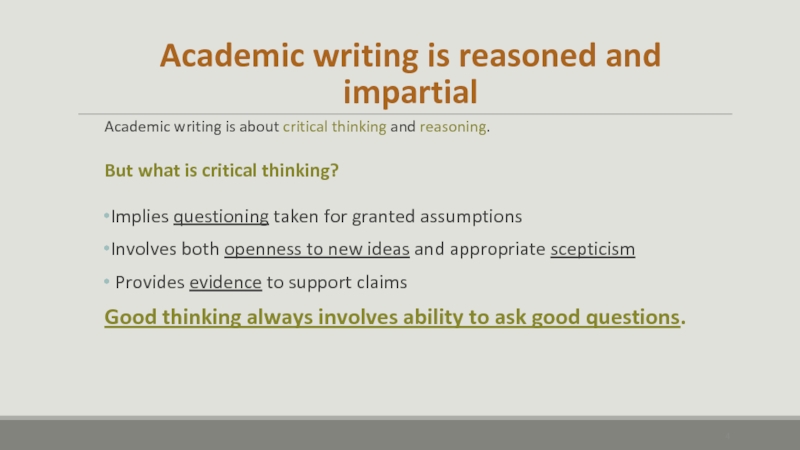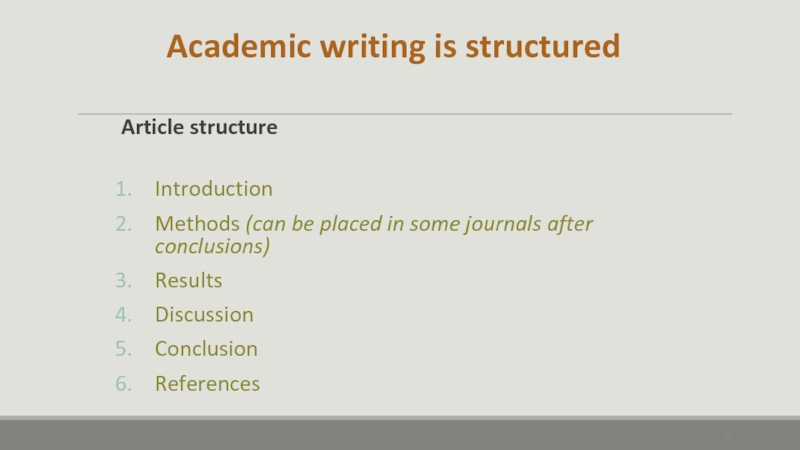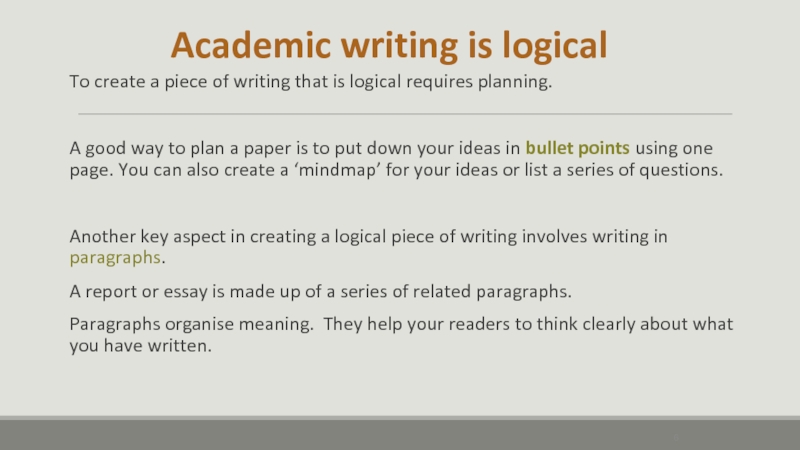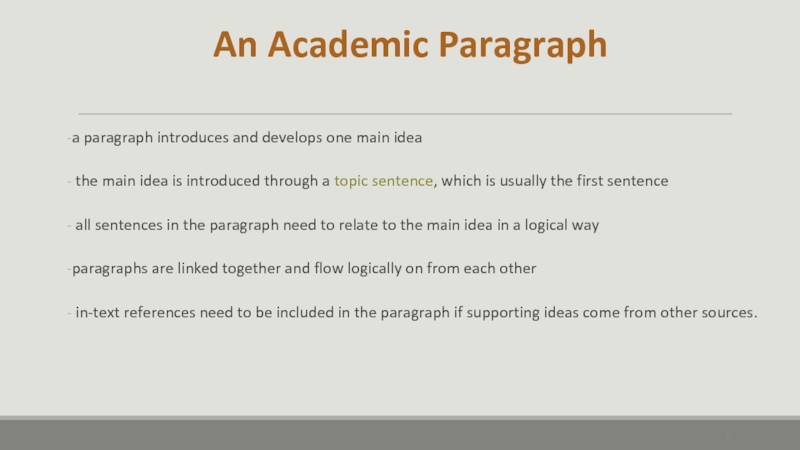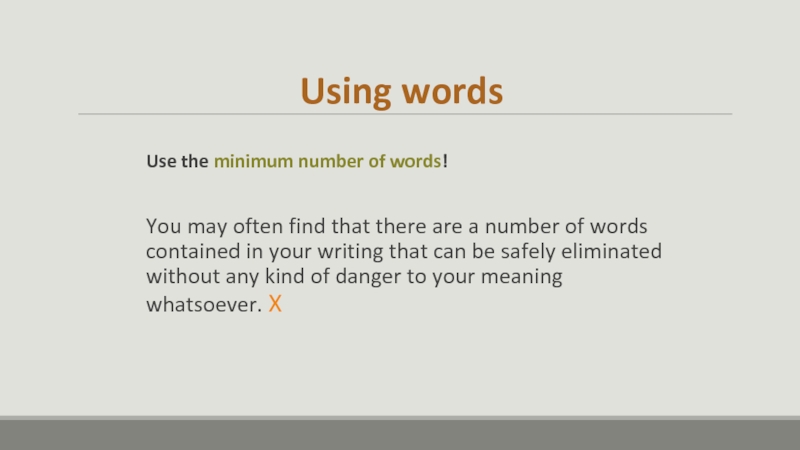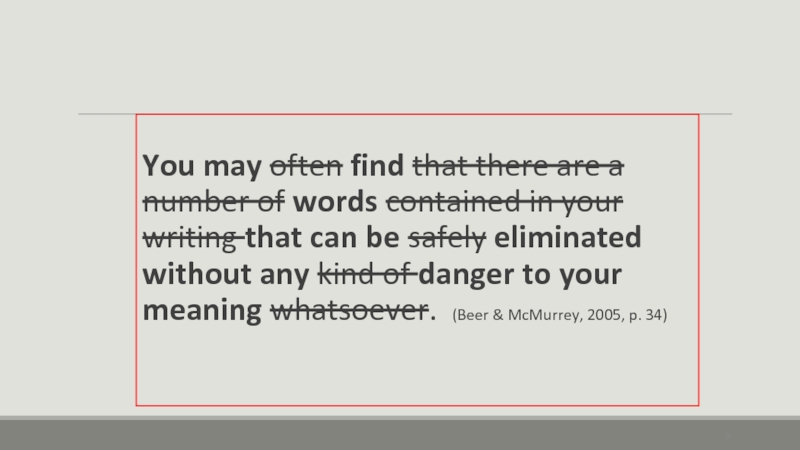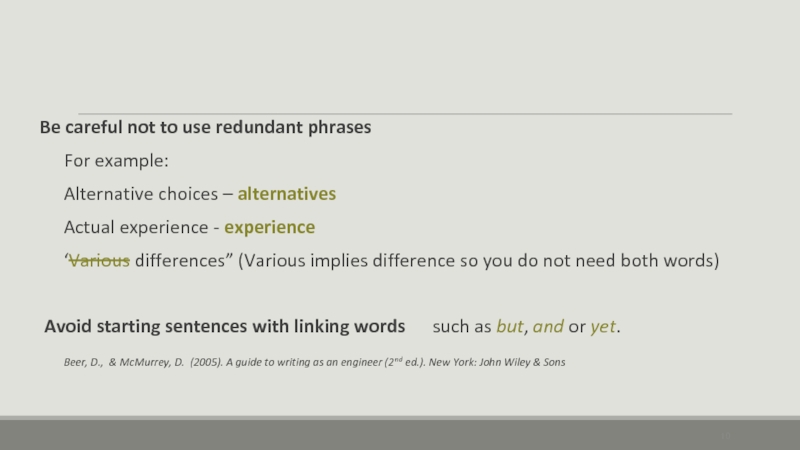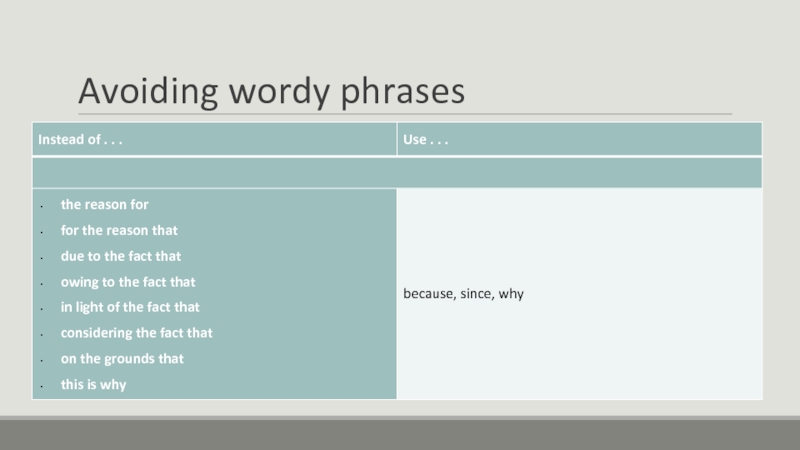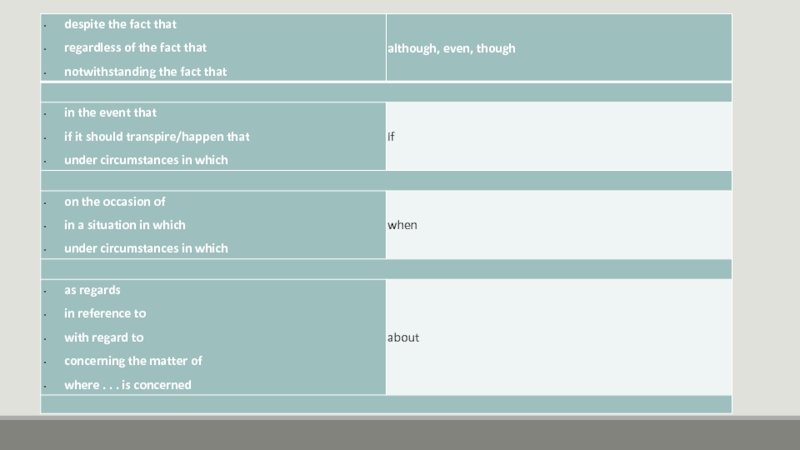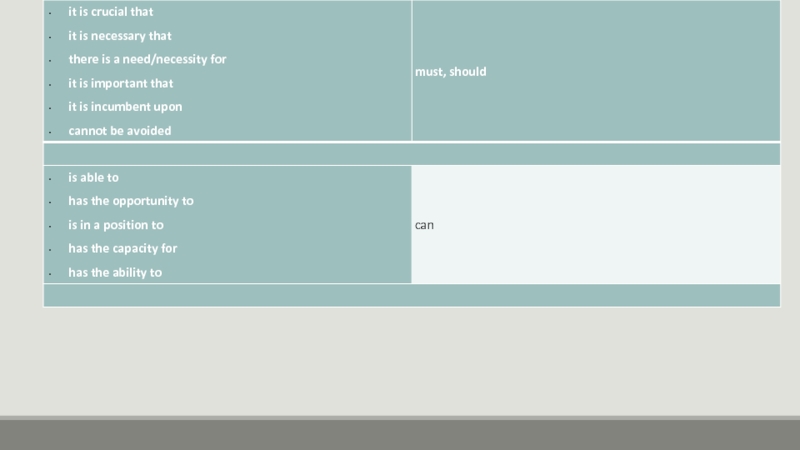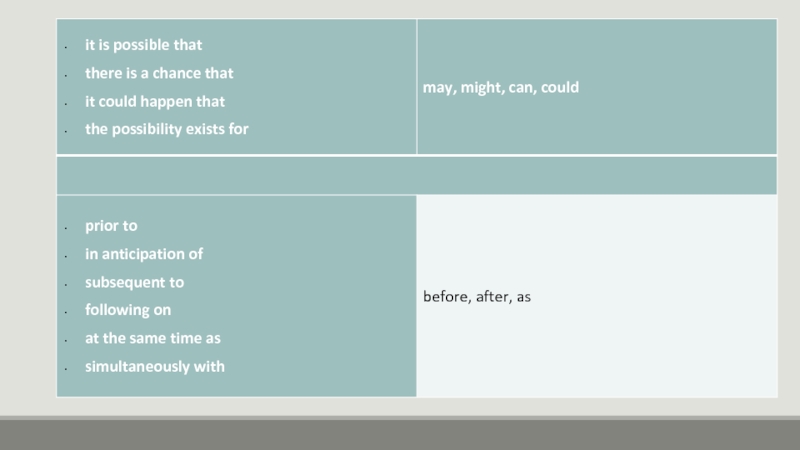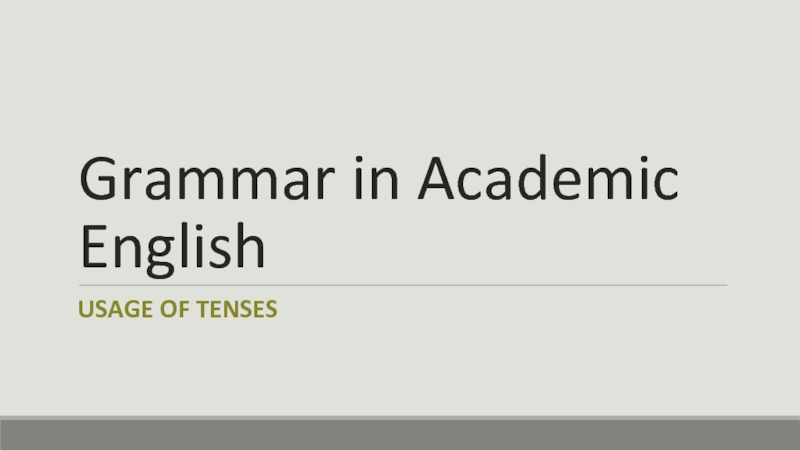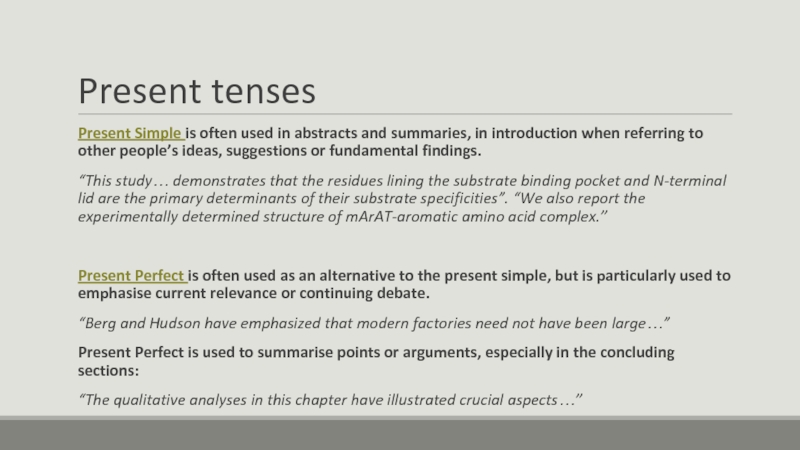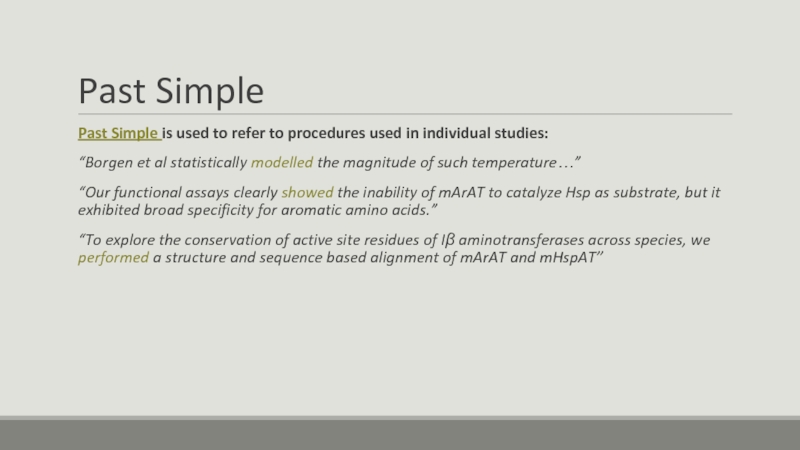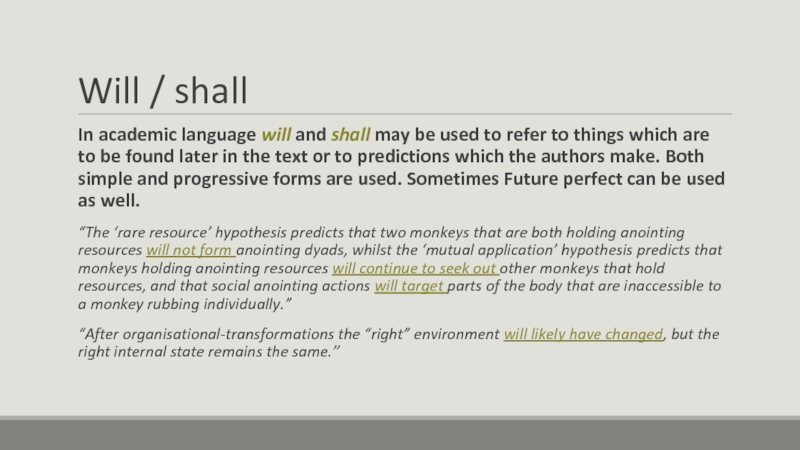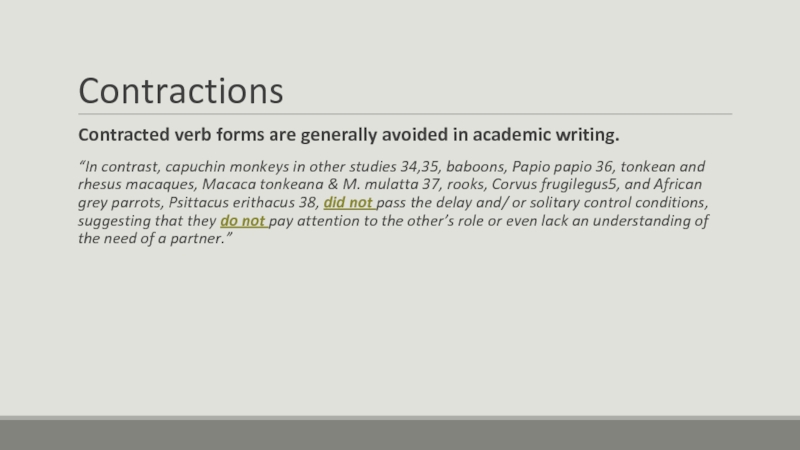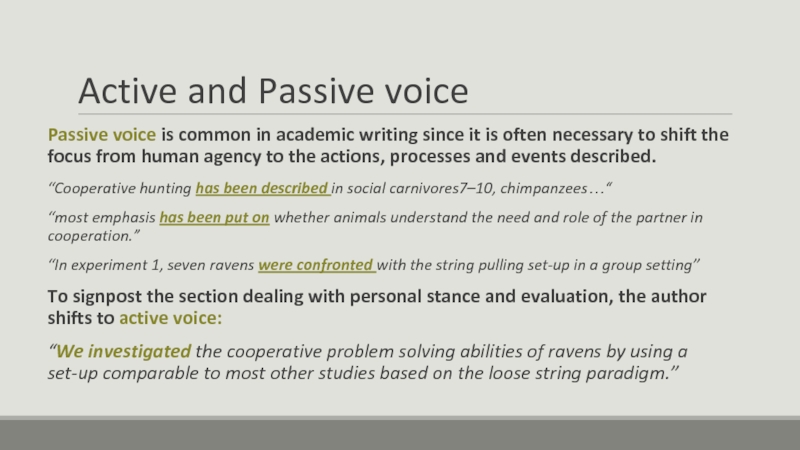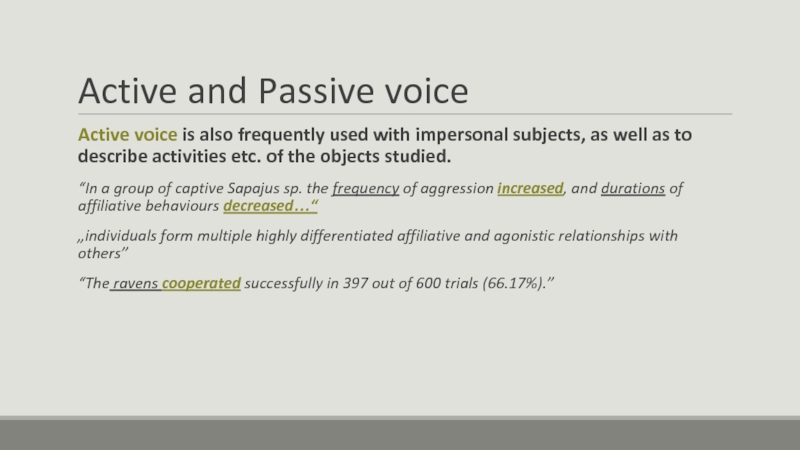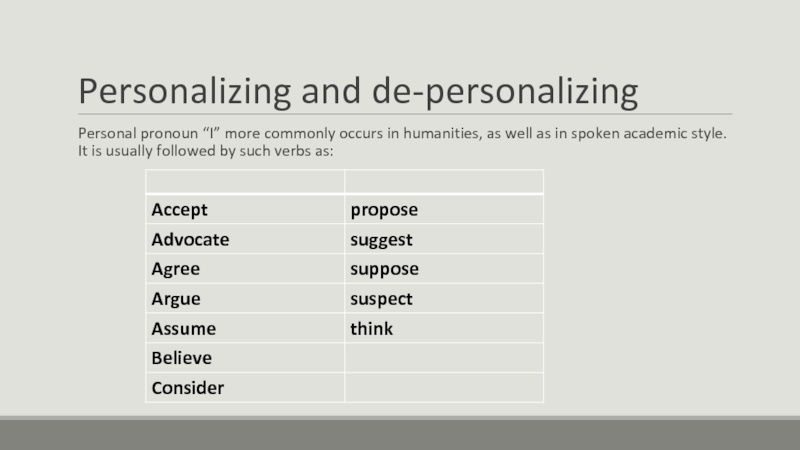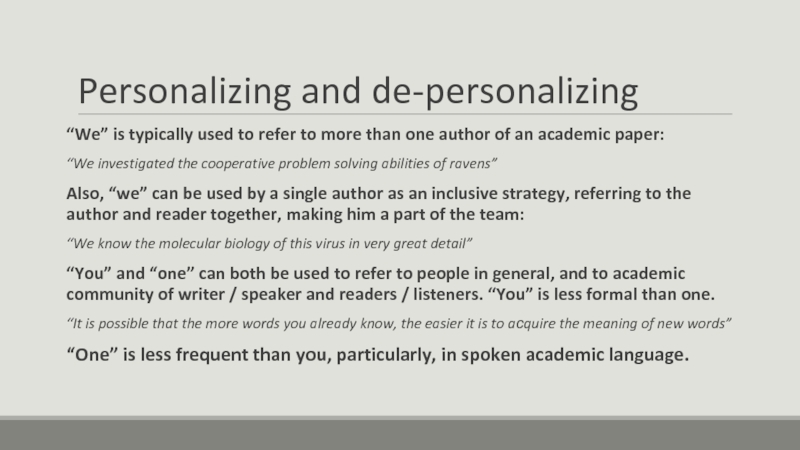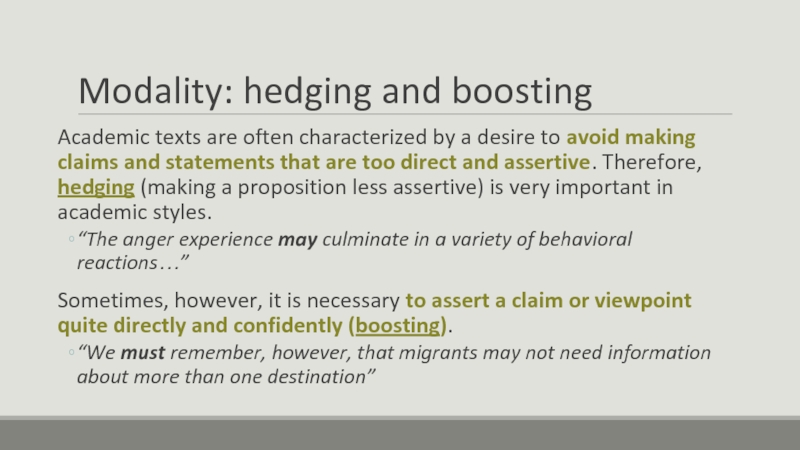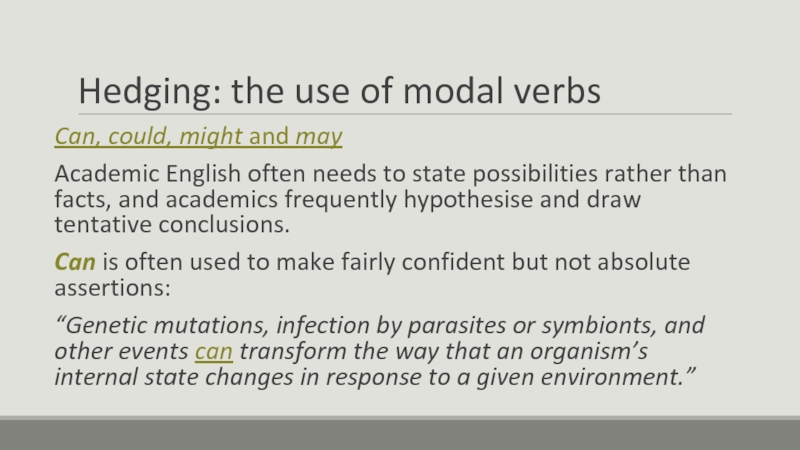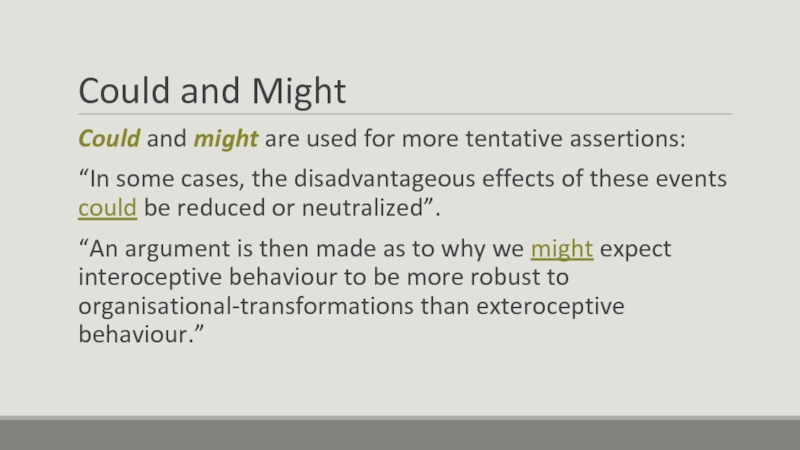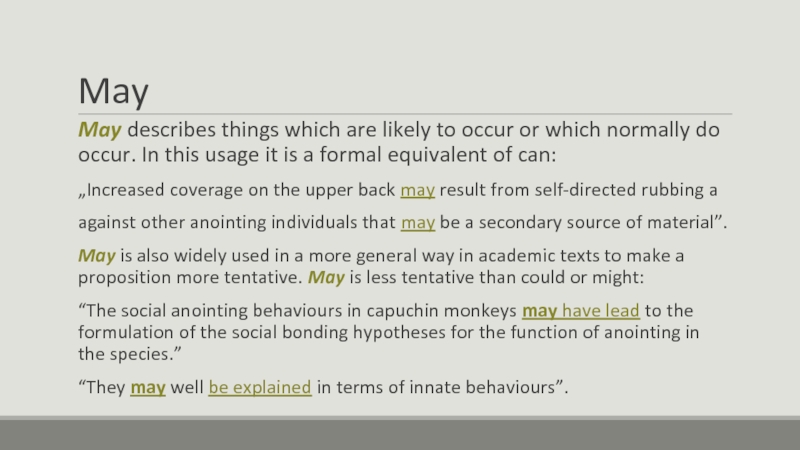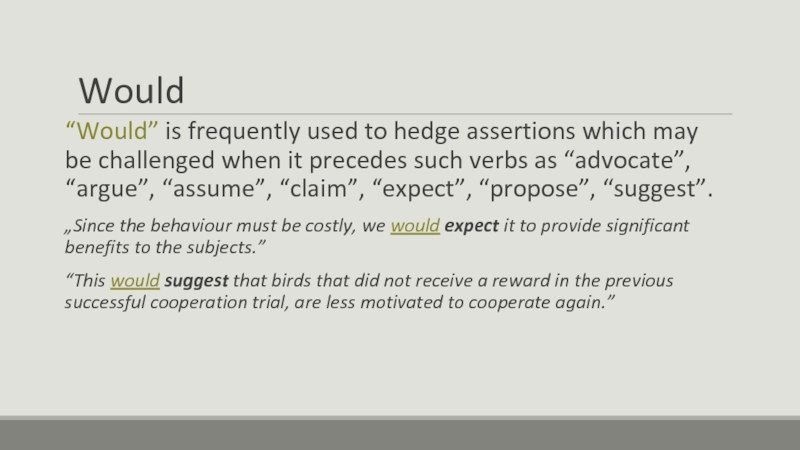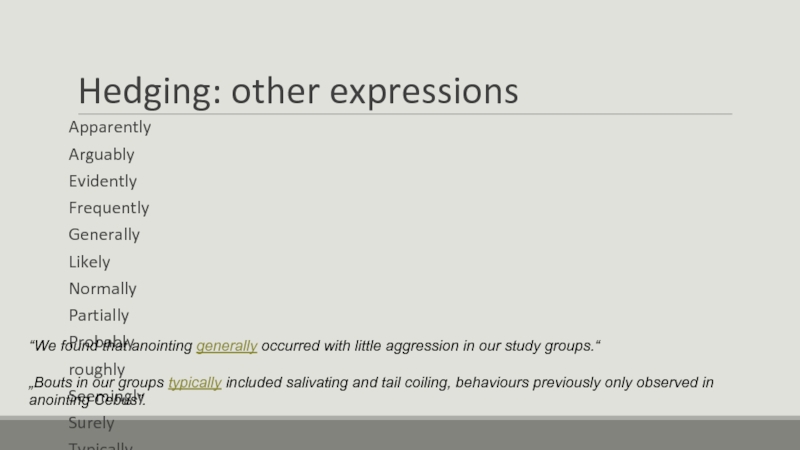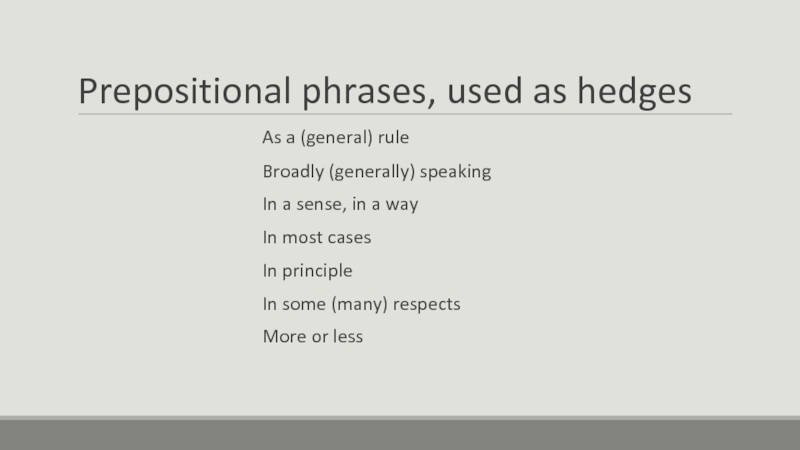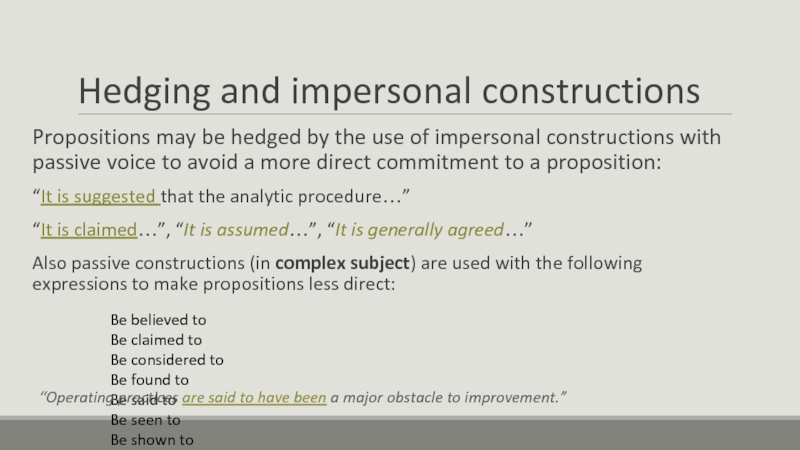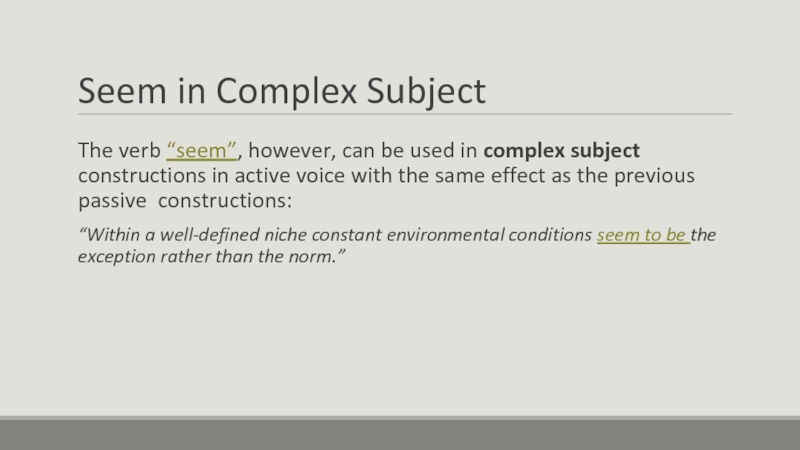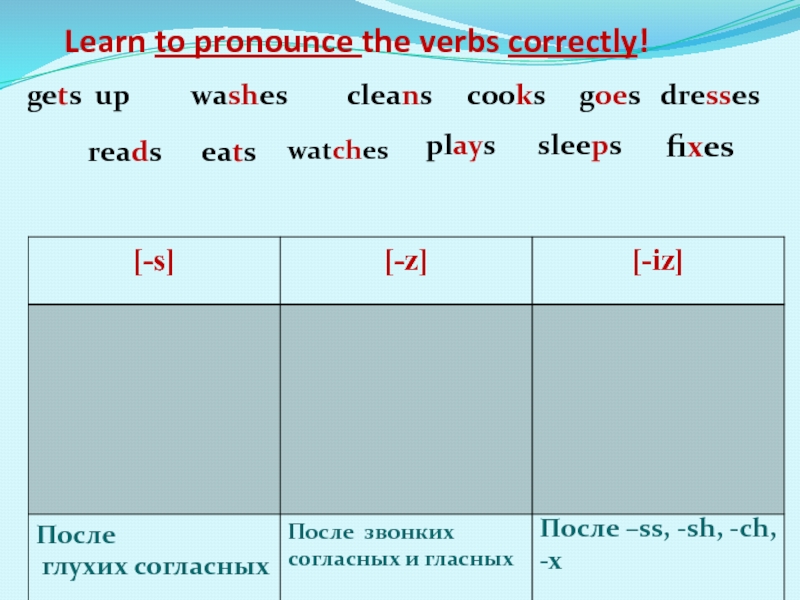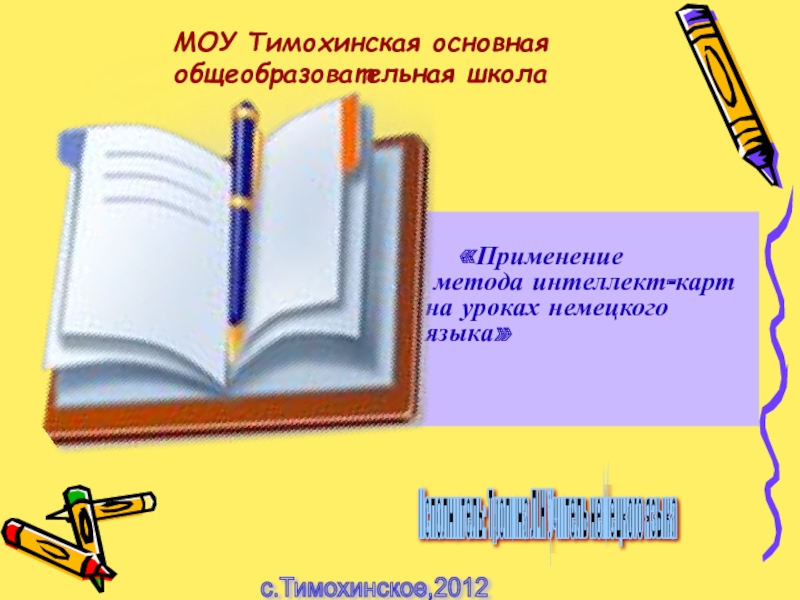- Главная
- Разное
- Дизайн
- Бизнес и предпринимательство
- Аналитика
- Образование
- Развлечения
- Красота и здоровье
- Финансы
- Государство
- Путешествия
- Спорт
- Недвижимость
- Армия
- Графика
- Культурология
- Еда и кулинария
- Лингвистика
- Английский язык
- Астрономия
- Алгебра
- Биология
- География
- Детские презентации
- Информатика
- История
- Литература
- Маркетинг
- Математика
- Медицина
- Менеджмент
- Музыка
- МХК
- Немецкий язык
- ОБЖ
- Обществознание
- Окружающий мир
- Педагогика
- Русский язык
- Технология
- Физика
- Философия
- Химия
- Шаблоны, картинки для презентаций
- Экология
- Экономика
- Юриспруденция
Academic language. (Part 1) презентация
Содержание
- 1. Academic language. (Part 1)
- 2. Academic writing is: Formal (impersonal, no slang,
- 3. Academic writing is formal In academic writing
- 4. Academic writing is reasoned and impartial Academic
- 5. Academic writing is structured Article structure
- 6. Academic writing is logical To create a
- 7. An Academic Paragraph a paragraph introduces and
- 8. Using words Use the minimum number
- 9. You may often find that there
- 10. Be careful not to use redundant phrases
- 11. Avoiding wordy phrases
- 15. Grammar in Academic English USAGE OF TENSES
- 16. Present tenses Present Simple is often used
- 17. Past Simple Past Simple is used to
- 18. Will / shall In academic language will
- 19. Contractions Contracted verb forms are generally avoided
- 20. Active and Passive voice Passive voice is
- 21. Active and Passive voice Active voice is
- 22. Personalizing and de-personalizing Personal pronoun “I” more
- 23. Personalizing and de-personalizing “We” is typically used
- 24. Modality: hedging and boosting Academic texts are
- 25. Hedging: the use of modal verbs Can,
- 26. Could and Might Could and might are
- 27. May May describes things which are likely
- 28. Would “Would” is frequently used to hedge
- 29. Hedging: other expressions Apparently Arguably Evidently Frequently
- 30. Prepositional phrases, used as hedges As a
- 31. Hedging and impersonal constructions Propositions may be
- 32. Seem in Complex Subject The verb “seem”,
Слайд 2Academic writing is:
Formal (impersonal, no slang, formal sentence structure)
Reasoned (critical thinking:
how and why)
Impartial (gives a balanced point of view, more than one point of view)
Logical (ideas flow logically from one to another: signposts, topic sentences and linked paragraphs)
Structured (keeps to the structure of an essay, report etc)
Supported (evidence and examples, referencing)
Impartial (gives a balanced point of view, more than one point of view)
Logical (ideas flow logically from one to another: signposts, topic sentences and linked paragraphs)
Structured (keeps to the structure of an essay, report etc)
Supported (evidence and examples, referencing)
Слайд 3Academic writing is formal
In academic writing we write more formally than
usual.
“In five experimental conditions we found that subjects took the recipients’ attentional state and their own communicative effectiveness into account by adjusting signal production accordingly. More importantly, in case of communicative failure, subjects repeated previously successful signals more often with a familiar than unfamiliar recipient…”
“In five experimental conditions we found that subjects took the recipients’ attentional state and their own communicative effectiveness into account by adjusting signal production accordingly. More importantly, in case of communicative failure, subjects repeated previously successful signals more often with a familiar than unfamiliar recipient…”
Слайд 4Academic writing is reasoned and impartial
Academic writing is about critical thinking
and reasoning.
But what is critical thinking?
Implies questioning taken for granted assumptions
Involves both openness to new ideas and appropriate scepticism
Provides evidence to support claims
Good thinking always involves ability to ask good questions.
But what is critical thinking?
Implies questioning taken for granted assumptions
Involves both openness to new ideas and appropriate scepticism
Provides evidence to support claims
Good thinking always involves ability to ask good questions.
Слайд 5Academic writing is structured
Article structure
Introduction
Methods (can be placed in some
journals after conclusions)
Results
Discussion
Conclusion
References
Results
Discussion
Conclusion
References
Слайд 6Academic writing is logical
To create a piece of writing that is
logical requires planning.
A good way to plan a paper is to put down your ideas in bullet points using one page. You can also create a ‘mindmap’ for your ideas or list a series of questions.
Another key aspect in creating a logical piece of writing involves writing in paragraphs.
A report or essay is made up of a series of related paragraphs.
Paragraphs organise meaning. They help your readers to think clearly about what you have written.
A good way to plan a paper is to put down your ideas in bullet points using one page. You can also create a ‘mindmap’ for your ideas or list a series of questions.
Another key aspect in creating a logical piece of writing involves writing in paragraphs.
A report or essay is made up of a series of related paragraphs.
Paragraphs organise meaning. They help your readers to think clearly about what you have written.
Слайд 7An Academic Paragraph
a paragraph introduces and develops one main idea
the
main idea is introduced through a topic sentence, which is usually the first sentence
all sentences in the paragraph need to relate to the main idea in a logical way
paragraphs are linked together and flow logically on from each other
in-text references need to be included in the paragraph if supporting ideas come from other sources.
all sentences in the paragraph need to relate to the main idea in a logical way
paragraphs are linked together and flow logically on from each other
in-text references need to be included in the paragraph if supporting ideas come from other sources.
Слайд 8Using words
Use the minimum number of words!
You may often find
that there are a number of words contained in your writing that can be safely eliminated without any kind of danger to your meaning whatsoever. X
Слайд 9
You may often find that there are a number of words
contained in your writing that can be safely eliminated without any kind of danger to your meaning whatsoever. (Beer & McMurrey, 2005, p. 34)
Слайд 10Be careful not to use redundant phrases
For example:
Alternative choices –
alternatives
Actual experience - experience
‘Various differences” (Various implies difference so you do not need both words)
Avoid starting sentences with linking words such as but, and or yet.
Beer, D., & McMurrey, D. (2005). A guide to writing as an engineer (2nd ed.). New York: John Wiley & Sons
Actual experience - experience
‘Various differences” (Various implies difference so you do not need both words)
Avoid starting sentences with linking words such as but, and or yet.
Beer, D., & McMurrey, D. (2005). A guide to writing as an engineer (2nd ed.). New York: John Wiley & Sons
Слайд 16Present tenses
Present Simple is often used in abstracts and summaries, in
introduction when referring to other people’s ideas, suggestions or fundamental findings.
“This study… demonstrates that the residues lining the substrate binding pocket and N-terminal lid are the primary determinants of their substrate specificities”. “We also report the experimentally determined structure of mArAT-aromatic amino acid complex.”
Present Perfect is often used as an alternative to the present simple, but is particularly used to emphasise current relevance or continuing debate.
“Berg and Hudson have emphasized that modern factories need not have been large…”
Present Perfect is used to summarise points or arguments, especially in the concluding sections:
“The qualitative analyses in this chapter have illustrated crucial aspects…”
“This study… demonstrates that the residues lining the substrate binding pocket and N-terminal lid are the primary determinants of their substrate specificities”. “We also report the experimentally determined structure of mArAT-aromatic amino acid complex.”
Present Perfect is often used as an alternative to the present simple, but is particularly used to emphasise current relevance or continuing debate.
“Berg and Hudson have emphasized that modern factories need not have been large…”
Present Perfect is used to summarise points or arguments, especially in the concluding sections:
“The qualitative analyses in this chapter have illustrated crucial aspects…”
Слайд 17Past Simple
Past Simple is used to refer to procedures used in
individual studies:
“Borgen et al statistically modelled the magnitude of such temperature…”
“Our functional assays clearly showed the inability of mArAT to catalyze Hsp as substrate, but it exhibited broad specificity for aromatic amino acids.”
“To explore the conservation of active site residues of Iβ aminotransferases across species, we performed a structure and sequence based alignment of mArAT and mHspAT”
“Borgen et al statistically modelled the magnitude of such temperature…”
“Our functional assays clearly showed the inability of mArAT to catalyze Hsp as substrate, but it exhibited broad specificity for aromatic amino acids.”
“To explore the conservation of active site residues of Iβ aminotransferases across species, we performed a structure and sequence based alignment of mArAT and mHspAT”
Слайд 18Will / shall
In academic language will and shall may be used
to refer to things which are to be found later in the text or to predictions which the authors make. Both simple and progressive forms are used. Sometimes Future perfect can be used as well.
“The ‘rare resource’ hypothesis predicts that two monkeys that are both holding anointing resources will not form anointing dyads, whilst the ‘mutual application’ hypothesis predicts that monkeys holding anointing resources will continue to seek out other monkeys that hold resources, and that social anointing actions will target parts of the body that are inaccessible to a monkey rubbing individually.”
“After organisational-transformations the “right” environment will likely have changed, but the right internal state remains the same.”
“The ‘rare resource’ hypothesis predicts that two monkeys that are both holding anointing resources will not form anointing dyads, whilst the ‘mutual application’ hypothesis predicts that monkeys holding anointing resources will continue to seek out other monkeys that hold resources, and that social anointing actions will target parts of the body that are inaccessible to a monkey rubbing individually.”
“After organisational-transformations the “right” environment will likely have changed, but the right internal state remains the same.”
Слайд 19Contractions
Contracted verb forms are generally avoided in academic writing.
“In contrast,
capuchin monkeys in other studies 34,35, baboons, Papio papio 36, tonkean and rhesus macaques, Macaca tonkeana & M. mulatta 37, rooks, Corvus frugilegus5, and African grey parrots, Psittacus erithacus 38, did not pass the delay and/ or solitary control conditions, suggesting that they do not pay attention to the other’s role or even lack an understanding of the need of a partner.”
Слайд 20Active and Passive voice
Passive voice is common in academic writing since
it is often necessary to shift the focus from human agency to the actions, processes and events described.
“Cooperative hunting has been described in social carnivores7–10, chimpanzees…“
“most emphasis has been put on whether animals understand the need and role of the partner in cooperation.”
“In experiment 1, seven ravens were confronted with the string pulling set-up in a group setting”
To signpost the section dealing with personal stance and evaluation, the author shifts to active voice:
“We investigated the cooperative problem solving abilities of ravens by using a set-up comparable to most other studies based on the loose string paradigm.”
“Cooperative hunting has been described in social carnivores7–10, chimpanzees…“
“most emphasis has been put on whether animals understand the need and role of the partner in cooperation.”
“In experiment 1, seven ravens were confronted with the string pulling set-up in a group setting”
To signpost the section dealing with personal stance and evaluation, the author shifts to active voice:
“We investigated the cooperative problem solving abilities of ravens by using a set-up comparable to most other studies based on the loose string paradigm.”
Слайд 21Active and Passive voice
Active voice is also frequently used with impersonal
subjects, as well as to describe activities etc. of the objects studied.
“In a group of captive Sapajus sp. the frequency of aggression increased, and durations of affiliative behaviours decreased…“
„individuals form multiple highly differentiated affiliative and agonistic relationships with others”
“The ravens cooperated successfully in 397 out of 600 trials (66.17%).”
“In a group of captive Sapajus sp. the frequency of aggression increased, and durations of affiliative behaviours decreased…“
„individuals form multiple highly differentiated affiliative and agonistic relationships with others”
“The ravens cooperated successfully in 397 out of 600 trials (66.17%).”
Слайд 22Personalizing and de-personalizing
Personal pronoun “I” more commonly occurs in humanities, as
well as in spoken academic style. It is usually followed by such verbs as:
Слайд 23Personalizing and de-personalizing
“We” is typically used to refer to more than
one author of an academic paper:
“We investigated the cooperative problem solving abilities of ravens”
Also, “we” can be used by a single author as an inclusive strategy, referring to the author and reader together, making him a part of the team:
“We know the molecular biology of this virus in very great detail”
“You” and “one” can both be used to refer to people in general, and to academic community of writer / speaker and readers / listeners. “You” is less formal than one.
“It is possible that the more words you already know, the easier it is to aсquire the meaning of new words”
“One” is less frequent than you, particularly, in spoken academic language.
“We investigated the cooperative problem solving abilities of ravens”
Also, “we” can be used by a single author as an inclusive strategy, referring to the author and reader together, making him a part of the team:
“We know the molecular biology of this virus in very great detail”
“You” and “one” can both be used to refer to people in general, and to academic community of writer / speaker and readers / listeners. “You” is less formal than one.
“It is possible that the more words you already know, the easier it is to aсquire the meaning of new words”
“One” is less frequent than you, particularly, in spoken academic language.
Слайд 24Modality: hedging and boosting
Academic texts are often characterized by a desire
to avoid making claims and statements that are too direct and assertive. Therefore, hedging (making a proposition less assertive) is very important in academic styles.
“The anger experience may culminate in a variety of behavioral reactions…”
Sometimes, however, it is necessary to assert a claim or viewpoint quite directly and confidently (boosting).
“We must remember, however, that migrants may not need information about more than one destination”
“The anger experience may culminate in a variety of behavioral reactions…”
Sometimes, however, it is necessary to assert a claim or viewpoint quite directly and confidently (boosting).
“We must remember, however, that migrants may not need information about more than one destination”
Слайд 25Hedging: the use of modal verbs
Can, could, might and may
Academic English
often needs to state possibilities rather than facts, and academics frequently hypothesise and draw tentative conclusions.
Can is often used to make fairly confident but not absolute assertions:
“Genetic mutations, infection by parasites or symbionts, and other events can transform the way that an organism’s internal state changes in response to a given environment.”
Can is often used to make fairly confident but not absolute assertions:
“Genetic mutations, infection by parasites or symbionts, and other events can transform the way that an organism’s internal state changes in response to a given environment.”
Слайд 26Could and Might
Could and might are used for more tentative assertions:
“In
some cases, the disadvantageous effects of these events could be reduced or neutralized”.
“An argument is then made as to why we might expect interoceptive behaviour to be more robust to organisational-transformations than exteroceptive behaviour.”
“An argument is then made as to why we might expect interoceptive behaviour to be more robust to organisational-transformations than exteroceptive behaviour.”
Слайд 27May
May describes things which are likely to occur or which normally
do occur. In this usage it is a formal equivalent of can:
„Increased coverage on the upper back may result from self-directed rubbing a
against other anointing individuals that may be a secondary source of material”.
May is also widely used in a more general way in academic texts to make a proposition more tentative. May is less tentative than could or might:
“The social anointing behaviours in capuchin monkeys may have lead to the formulation of the social bonding hypotheses for the function of anointing in the species.”
“They may well be explained in terms of innate behaviours”.
„Increased coverage on the upper back may result from self-directed rubbing a
against other anointing individuals that may be a secondary source of material”.
May is also widely used in a more general way in academic texts to make a proposition more tentative. May is less tentative than could or might:
“The social anointing behaviours in capuchin monkeys may have lead to the formulation of the social bonding hypotheses for the function of anointing in the species.”
“They may well be explained in terms of innate behaviours”.
Слайд 28Would
“Would” is frequently used to hedge assertions which may be challenged
when it precedes such verbs as “advocate”, “argue”, “assume”, “claim”, “expect”, “propose”, “suggest”.
„Since the behaviour must be costly, we would expect it to provide significant benefits to the subjects.”
“This would suggest that birds that did not receive a reward in the previous successful cooperation trial, are less motivated to cooperate again.”
„Since the behaviour must be costly, we would expect it to provide significant benefits to the subjects.”
“This would suggest that birds that did not receive a reward in the previous successful cooperation trial, are less motivated to cooperate again.”
Слайд 29Hedging: other expressions
Apparently
Arguably
Evidently
Frequently
Generally
Likely
Normally
Partially
Probably
roughly
Seemingly
Surely
Typically
usually
“We found that anointing generally occurred with little aggression
in our study groups.“
„Bouts in our groups typically included salivating and tail coiling, behaviours previously only observed in anointing Cebus”.
„Bouts in our groups typically included salivating and tail coiling, behaviours previously only observed in anointing Cebus”.
Слайд 30Prepositional phrases, used as hedges
As a (general) rule
Broadly (generally) speaking
In a
sense, in a way
In most cases
In principle
In some (many) respects
More or less
In most cases
In principle
In some (many) respects
More or less
Слайд 31Hedging and impersonal constructions
Propositions may be hedged by the use of
impersonal constructions with passive voice to avoid a more direct commitment to a proposition:
“It is suggested that the analytic procedure…”
“It is claimed…”, “It is assumed…”, “It is generally agreed…”
Also passive constructions (in complex subject) are used with the following expressions to make propositions less direct:
“It is suggested that the analytic procedure…”
“It is claimed…”, “It is assumed…”, “It is generally agreed…”
Also passive constructions (in complex subject) are used with the following expressions to make propositions less direct:
Be believed to
Be claimed to
Be considered to
Be found to
Be said to
Be seen to
Be shown to
Be thought to
“Operating practices are said to have been a major obstacle to improvement.”
Слайд 32Seem in Complex Subject
The verb “seem”, however, can be used in
complex subject constructions in active voice with the same effect as the previous passive constructions:
“Within a well-defined niche constant environmental conditions seem to be the exception rather than the norm.”
“Within a well-defined niche constant environmental conditions seem to be the exception rather than the norm.”
